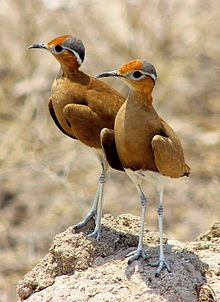Burchell's courser
| Burchell's courser | |
|---|---|

| |
| C. rufus pair in Namibia | |
| Scientific classification | |
| Domain: | Eukaryota |
| Kingdom: | Animalia |
| Phylum: | Chordata |
| Class: | Aves |
| Order: | Charadriiformes |
| Family: | Glareolidae |
| Genus: | Cursorius |
| Species: | C. rufus
|
| Binomial name | |
| Cursorius rufus Gould, 1837
| |

| |
Burchell's courser (Cursorius rufus) is a wader in the pratincole and courser family, Glareolidae.[2] The name of this bird commemorates the English naturalist William John Burchell.[3]
Native to Africa, Burchell's courser is a small,
Description

Burchell's courser has a graceful figure and an upright posture. It has a blue-grey hind crown which is mainly how it differs from the similar Temminck's Courser.[5] It also has a horizontal black band demarcating a white underbelly, and an overall pale rufous colour.[5] Its face features white supercilia above black eye lines, all ending at the back of the neck to form a double V.[6] In terms of feathers, its secondaries are mostly white with a black underwing and brown to grey coverts.[6] Typical of coursers, its bill is long, arched down, and of a dark colour like its eyes.[7] Similar to the underbelly, the legs are of a distinctive creamy white.[6][5] While flying, the Burchell's courser's feet extend past its tail.[6]
Females and males look similar, while juveniles lack the rufous colouring, the facial stripes, and the grey hind crown of the adults.[7] They also are mottled, with black and beige barring.[5][7] Overall, the Burchell's courser, with its camouflage appearance, blends in with the landscape making it challenging to spot.
| Measurements (mm) | |
|---|---|
| height | 200-225 |
| bill | 19-24 |
| wing | 123-145 |
| tail | 45-53 |
| tarsus | 43-58 |
Taxonomy
Burchell's courser belongs to the order Charadriiformes which mainly refers to birds living near water.[8] Characterized by a curved beak and nostrils located at the base of the nose, the Burchell's courser is part of the Glareolidae family, specifically belonging to the courser group. Its genus, Cursorius, contains five species, all of which live in the arid parts of the Old World and display distinctive features such as long legs and short wings.[9]
Burchell's courser and its close relative, C. cursor, have at times been referred to as the same species.[6][5] However, although they have a direct common ancestor, they should not be considered as such.[10] C. rufus is monotypic and does not have any subspecies.[5]
Distribution and habitat

Burchell's courser inhabits deserts or semi deserts with gravel rather than just sand, but also open grasslands with short grass, and sparse, burnt, or overgrazed vegetation.[5][6][7] It is often referred as locally nomad based on its movements at the landscape level, possibly travelling due to fluctuations in rainfall.[5][13][14] Although it is classified as least concern, Its population is declining, potentially due to its habitat loss on arable lands, inadequate farming practices such as intense irrigation and overuse of pesticides, and other anthropogenic disturbances.[2][12][15]
Behaviour
The adults have developed a
Voice
Burchell's courser often prefers to run rather than fly, and will most likely take to the air only when the disturbance is significant.
Feeding
Burchell's courser is predominantly an
Breeding
Burchell's coursers may occur in small flocks but are mostly solitary, monogamous birds.[5][7] They have developed an all-year-round breeding strategy due to their nomadic movements,[13][14] although they often breed just before the wet season between July and December.
With a small clutch size, the Burchell's courser only lays two eggs directly on the ground, sometimes surrounded by stools of antelopes, small rocks, or dried up organic matter.[7][9] The eggs have an oval shape, and look black from afar, but they are actually of a buff colour with many dark markings.[7][9] There is a lot of uncertainty when it comes to the hatching and fledging times, but it is believed that both parents participate in the incubation period.[7]
References
- . Retrieved 12 November 2021.
- ^ ISBN 9781400874170. Retrieved 11 May 2016.
- ISBN 9780713666472.
- ^ a b c Ekstrom, J.; Butchart, S.; Malpas, L. (2016). "Species factsheet: Cursorius rufus". BirdLife International. Retrieved 11 May 2016.
- ^ a b c d e f g h i j k l m n o Maclean, G.L.; Kirwan, G.M. (2016). "Handbook of the Birds of the World Alive: Burchell's Courser (Cursorius rufus)". Barcelona, Spain: Lynx Edicions. Retrieved 11 May 2016.
- ^ ISBN 978-1-4081-3515-0.
- ^ ISBN 978-1-4729-8640-5.
- ^ "ITIS Standard Report Page: Cursorius rufus". www.itis.gov. Retrieved 2020-10-12.
- ^ a b c d e f "Pratincoles and Coursers (Glareolidae) | Encyclopedia.com". www.encyclopedia.com. Retrieved 2020-10-12.
- ISSN 0012-723X.
- JSTOR 40979681.
- ^ a b International), BirdLife International (BirdLife (2016-10-01). "IUCN Red List of Threatened Species: Cursorius rufus". IUCN Red List of Threatened Species. Retrieved 2020-10-12.
- ^ JSTOR 2846114.
- ^ ISSN 0019-1019.
- S2CID 129638419.
- ^ ISSN 2410-7220.
External links
- Burchell's courser in The Atlas of Southern African Birds
- Burchell's courser Cursorius rufus at The Cornell Lab of Ornithology
- Burchell's courser photo gallery at VIREO
- Burchell's courser photo gallery at eBird


